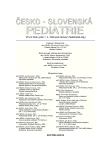Occurrence of Metabolic Syndrome and Its Components in Obese Children
Authors:
E. Vitáriušová; Ľ. Košťálová; Z. Pribilincová; A. Hlavatá; L. Kovács
Authors‘ workplace:
2. detská klinika Lekárskej fakulty Univerzity Komenského a Detskej fakultnej nemocnice s poliklinikou, Bratislava
prednosta prof. MUDr. L. Kovács, DrSc., MPH
Published in:
Čes-slov Pediat 2010; 65 (2): 55-61.
Category:
Original Papers
Overview
Following an increasing prevalence of exogenous obesity in children there is an evidence of more frequent changes in their lipid and glucose metabolism, mediated by insulin resistance. These metabolic changes together with obesity and arterial hypertension are a part of metabolic syndrome.
The aim of study was to evaluate the incidence of obesity complications in childhood in different age groups and prevalence of metabolic syndrome according to the latest partially modified criteria in studied group. In children less than 10 years old there were lower levels of HOMA index and no impaired glucose tolerance found, but 38.1% of probands suffered from hypercholesterolemia. In the group of patients aged 10 to 16 years there was insulin resistance present in 37.7%, increased levels of triglycerides (53.3%), low HDL cholesterol levels (54.4%) and almost in 8% impaired glucose tolerance appeared in this elder age group. Based on modified IDF criteria we have diagnosed metabolic syndrome in 32.5% of studied group patients, while using percentile borderline criteria for blood pressure the percentage of metabolic syndrome increased to 39%. Therapy of referred pathological states requires lifestyle changes and follow-up at the specialized clinic.
Key words:
obesity, childhood, complications, metabolic syndrome
Sources
1. Speiser PW, Rudolf CJM, Anhalt H, et al. Consensus statement: Childhood obesity. J. Clin. Endocrinol. Metabol. 2005; 90: 1871–1887.
2. Dukát A, Lietava J, Luliak M, et al. Epidemiológia nadváhy a obezity na Slovensku. Via Practica 2008; 3: 111–114.
3. Ford ES, Li Ch. Defining the metabolic syndrome in children and adolescents: will the real definition please stand up? J. Pediatr. 2008; 152: 160–164.
4. Zimmet P, Alberti KGMM, Kaufman F, et al. The metabolic syndrome in children and adolescents – an IDF consensus report. Pediatric Diabetes 2007; 8: 299–306.
5. Kolektív autorov. Telesný vývoj detí a mládeže v SR. Výsledky VI. Celoštátneho prieskumu v roku 2001. Bratislava: Úrad verejného zdravotníctva SR, 2004: 36–103.
6. Bláha P, Lhotská L, Šrajer J, et al. Percentilové grafy BMI a Rohrerova indexu. Čes.-slov. Pediat. 1994; 49: 323–327.
7. National High Blood Pressure Education Program Working Group in High Blood Pressure in Children and Adolescent. The Fourth Report on the diagnosis, evaluation and treatment of high blood pressure in children and adolescent. Pediatrics 2004; 114: 555–576.
8. World Health Organization. Definition, diagnosis and classification of diabetes mellitus and its complications: report of a WHO Consultation. Part 1: Diagnosis and classification of diabetes mellitus. Geneva, Switzerland: World Health Organization, 1999. Available at: http://whqlibdoc.who.int/ 1999/WHO_NCD_NCS_99.2.pdf. acecessed December 12, 2003.
9. Keskin M, Kurtoglu S, Kendirci M, et al. Homeostasis model assessment is more reliable than the fasting glucose/insulin ratio and quantitative insulin sensitivity check index for assessing resistance among obese children and adolescents. Pediatrics 2005; 115.
10. Marinov Z. Rizika dětské obezity. Čes-slov. Pediat. 2009; 64: 141–146.
11. Chiarelli F, Marcovecchio ML. Insulin resistance and obesity in childhood. Eur. J. Endocrinol. 2008; 159: 67–74.
12. Reaven GM. The metabolic syndrome: Requiescat in pace. Clinical Chemistry 2005; 51(6): 931–938.
13. Shalitin S, Abrahami M, Lilos P, et al. Insulin resistance and impaired glucose tolerance in obese children and adolescents reffered to a tertiary – care center in Israel. Inter. J. Obesity 2005; 29: 571–578.
14. Hettihawa LM, Palangasinghe S, Jayasinghe SS, et al. Comparison of insulin resistance by indirect methods – HOMA, QUICKI and McAuley – with fasting insulin in patients with type 2 diabetes in Galle, Sri Lanka: A pilot sudy. Online Journal of Health Allied Sciences. 2006; 5: 1 – 8. www.ojhas.org/issue17/2006-1-2.htm.
15. Hirschler V, Calcagno ML, Aranda C, et al. Can the metabolic syndrome identify children with insulin resistance? Pediatric Diabetes 2007; 8: 272–277.
16. Staník J, Schrone Z, Pribilincová Z, et al. Diabetes mellitus 2. typu ako nový fenomén v detskej diabetológii. Diabetes a obezita 2006; 6: 10–33.
17. Kohen-Avramoglu R, Theriault A, Adeli K. Emergence of the metabolic syndrome in childhood: an epidemiological overview and mechanistic link to dyslipidemia. Clinical Biochemistry 2003; 36: 413–420.
18. Rosipal Š. Návrh pokynov pre prevenciu, diagnostiku a liečbu detskej tučnoty. Čes-slov. Pediat. 2009; 64: 415–421.
19. Weiss R, Gillis D. Patho-physiology and dynamics of altered glucose metabolism in obese children and adolescent. Inter. J. Pediatr. Obesity 2008; 3: 15–20.
20. Love-Osborne K, Butlerb N, Gaoc D, et al. Elevated fasting triglycerids predict impaired glucose tolerance in adolescents at risk for type 2 diabetes. Pediatric Diabetes 2006; 7: 205–210.
21. Calcaterra V, Klersy C, Muratori T, et al. Prevalence of metabolic syndrome (MS) in children and adolescent with varying degrees of obesity. Clin. Endocrinol. 2008; 68: 868–872.
22. Velaquez-Mieyer P, Perez-Faustinelli S, Cowan PA. Identifying children at risk for obesity, type 2 diabetes, and cardiovascular disease. Diabetes Spectrum 2005; 18: 213–220.
23. Ford ES, Li Ch, Zhao G, et al. Prevalence of Metabolic Syndrome among U.S. adolescents using the definition from the Internatiol Diabetes Federation. Diabetes Care 2008; 31: 587–589.
24. Morrison JA, Friedman LA, McGuire C. Metabolic syndrome in childhood predicts adult cardiovascular disease 25 years later: The Princeton Lipid Research clinics. Follow-up study. Pediatrics 2007; 120: 340–345.
25. Lisá L, Kytnarová J, Stožicky F, et al. Doporučený postup prevence a léčby dětské obezity. Čes.- slov. Pediat. 2008; 63, 501–507.
26. Hlavatá A. Obézne dieťa v ambulancii lekára pre deti a dorast. Klinické odporúčania I. Pediatria pre prax 2007; 8: 12–16.
Labels
Neonatology Paediatrics General practitioner for children and adolescentsArticle was published in
Czech-Slovak Pediatrics

2010 Issue 2
Most read in this issue
- Acute Kidney Injury – Classification, Etiology, Diagnosis
- Disorders of Sex Development: Currently Recommended Classification and New Knowledge of Gonadal Maldevelopment
- Acute Pyelonephritis – A Questionnaire Study of Diagnostics and Treatment in the Czech Republic
- Occurrence of Metabolic Syndrome and Its Components in Obese Children
